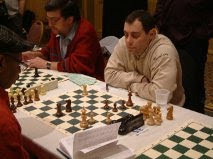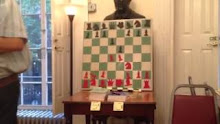To the best of my recollection, Asa has played the Trompovsky Attack 1.d4 Nf6 2.Bg5 against me on three occasions. I won the first encounter in 1982 at the Bar Point in New York City by making a speculative piece sacrifice in an inferior position and was fortunate that Black led a charmed life in so many of the ensuing variations.
Asa got his revenge at the 1986 U.S. Open, held in Somerset, with a quick 19-move crush in which I defended poorly.
The third contest, played in May 1988 at the Manhattan Chess Club, is the one that Asa included in his book. Although he does not refer to it as such in print, fellow players at the Manhattan tell me that he has described it as "the immortal Zwischenzug game" because there are three critical junctures when a white knight gains valuable time by an in-between attack against the black queen. Here is the game, with annotations by Asa Hoffmann [AH] and myself [JW].
FM Asa Hoffmann - NM Jim West, Manhattan Chess Club 1988
1.d4 Nf6 2.Bg5 c5
I have always answered the Trompovsky Attack (or the Ruth Attack, as The New York Times chess columnist Robert Byrne calls it, in honor of the Philadelphia master Bill Ruth, who championed it in the 1920's) with 2...c5, influenced by the game Letelier-Fischer, Mar del Plata 1960 which continued: 3.c3?! (better are 3.Bxf6 and 3.d5) Qb6 4.Qb3 cxd4 5.Qxb6 axb6 6.Bxf6 gxf6 7.cxd4 Nc6 8.Nf3 Nb4 9.Kd2 Rxa2 10.Rxa2 Nxa2 with a pawn-up advantage which enabled Fischer to win in 36 moves.
Also possible is 2...Ne4 3.Bf4 (3.h4 d5 4.Nd2 Bf5 5.Nxe4 Bxe4 6.f3 h6 7.fxe4 hxg5 8.Qd3 e6 9.Qb5+ Nc6 10.Qxb7 Nb4! with advantage to Black and 0-1 in 44 moves, Hodgson-Salov, Netherlands 1993) d5 (3...c5 4.f3 Qa5+ 5.c3 Nf6 6.d5 e6 7.e4 exd5 8.exd5 d6 9.Ne2!? Nbd7 10.Nd2 Nb6 11.b4! cxb4 12.c4 with compensation and 1-0 in 60 moves, Gulko-Browne, U.S.Championship 1992) 4.f3 Nf6 5.e4!? [JW], and now:
(a) 5...dxe 6.Nc3 exf3 7.Nxf3 e6 (7...g6 8.Bc4 Bg7 9.Qe2 O-O 10.O-O-O c6 11.d5!, Hodgson-Panchenko, Bern 1994) 8.Bc4 c6 9.Qe2 with compensation, Jansa-Sosonko, Amsterdam 1975 [JW].
(b) 5...e6 6.e5 Nfd7 7.Be3 c5 8.c3 Nc6 9.f4 cxd4 10.cxd4 Nb6 (10...Qa5+ 11.Kf2 Nb6 12.b3 Bd7 13.Nf3 Rc8 14.a3 Na8 15.Ra2 Ne7 16.Bd2 Qb6 17.Nc3 Nf5 18.b4!, Benjamin-Malishauskas, Moscow 1994) 11.Nd2 a5 12.a3 a4 13.Bd3 Bd7 14.Ne2 Na5 15.O-O g6 16.g4 Bc6 17.Ng3 Nbc4 18.Nxc4 Nxc4 19.Qe2 b5 20.f5 with advantage, Benjamin-Popovic, Moscow 1994 [JW].
A rare continuation occurred in the game Levitina-Khan, U.S. Women's Championship 1993: 2...d6 3.Nc3 (3.Bxf6!?) Nbd7 4.e4 e5 5.f4 h6 6.Bxf6 Qxf6 7.Qd2 c6 8.Nge2 Nb6 9.O-O-O Bg4 10.g3 exd4 11.Qxd4 Qxd4 12.Rxd4 O-O-O with the better endgame for Black (0-1, 40) [JW].
3.Bxf6
Instead 3.d5 Qb6 4.Nc3 Qxb2 5.Bd2 Qb6 6.e4 leads to a strong attack [AH], but Asa may have remembered our 1982 game which proceeded: 6...d6 7.f4 e6 8.Nf3 Be7 9.Rb1 Qd8 10.Bb5+ Bd7 11.dxe6 fxe6 12.Ng5 O-O 13.Bc4 Qc8 14.f5 Nxe4!? 15.fxe6 Bc6 16.Ngxe4 b5!? [JW] with unclear play (0-1, 27). After 3.d5, Black can also try 3...Ne4!, followed by 4...Qb6, with chances for both sides [AH].
3...gxf6 4.d5 Qb6 5.Qc1 f5
Many books recommend 5...Bh6, but Asa labels this move "naive" because after 6.e3 the dark-squared bishop usually loses a tempo by withdrawing to g7.
6.g3
One month earlier, at the Toms River quads in April 1988, future N.J. state champion David Levin played 6.e3 against me, but after 6...Bg7 7.c3 e6 8.dxe6 fxe6 9.Nd2 d5 10.Bd3 Nc6 11.Ne2 Bd7 12.O-O O-O-O 13.Rb1 Ne5 14.Bc2 Bb5 15.Re1 Nd3 16.Bxd3 Bxd3 17.Ra1 Bxe2 18.Rxe2 Kb8 19.Qc2 Rhf8 20.Rae1 e5 Black had the advantage, although the game was eventually drawn [JW].
6...Bg7 7.c3 e6
Alternatives are:
(a) 7...O-O 8.Nd2 d6 9.Bg2 Bd7 10.Nh3!?, Krishko-Privarg, 1980 [AH].
(b) 7...h5 8.h4 Qf6 9.Nh3 e5 10.dxe6 fxe6 11.Bg2 Nc6 12.Na3 d5 13.Nf4, Mikadze-Ghinda, 1976 [AH].
8.Bg2
Better is 8.Nh3! h5 9.Nd2 d6 10.Nc4 Qd8 11.Qd2 e5 12.f4 b5 13.Ne3 h4 14.Bg2, Ermenkov-Kouatley, 1984 [AH].
8...Qd6?! 9.Qd2 O-O 10.Na3 Qa6 11.e3 e5
12.d6! f4 13.Rd1 Nc6 14.Ne2 b5! 15.O-O fxe3 16.Qxe3 b4 17.Nb1 Bb7 18.Nd2
On 18.Bd5, guarding the a2 pawn, Black can answer 18...Nd4! [AH].
18...Qxa2 19.Ne4 Ba6
20.Nc1!
This is Zwischenzug number one. On the immediate 20.Nxc5, Black counters with 20...Bxe2 21.Qxe2 bxc3 22.Nxd7 Nd4 [AH].
20...Qa5 21.Rfe1 bxc3 22.bxc3 f5!
23.Nb3!
And this is the second Zwischenzug. Of course, White must avoid 23.Nxc5? f4! [AH].
23...Qd8 24.Nexc5 Bc4 25.Nd2 Bf7 26.Qf3 Be8 27.Qe2 e4?!
More prudent is 27...Bf7 [AH], but after moving my light-squared bishop five times I was reluctant to move it again.
28.g4! Qb6 29.Na6 Ne5 30.Nc7 Rc8 31.gxf5 Nd3 32.Nxe4 Nxe1
33.Nd5!
The final Zwischenzug!
33...Qb3 34.Rxe1
Less convincing is 34.Ne7+ Kh8 35.Nxc8 Nxg2 36.Kxg2 Rxf5 [AH].
34...Kh8 35.Ne7 Rb8 36.Qe3! a5 37.f6 Rxf6!
White wins after 37...Bxf6 38.Nxf6 Rxf6 39.Qe5 Qf7 40.Nd5 Kg7 41.Re3 [AH].
38.Nxf6 Bxf6 39.Nd5 Bg7 40.Be4!
But not 40.Qxe8+? Rxe8 41.Rxe8+ Bf8 42.Rxf8+ Kg7 43.Rf5 Qd1+ 44.Bf1 Qg4+ [AH].
41...Bg6
No better is 40...Bf7 41.Qh3 Bg8 (41...h6 42.Qf5) 42.Ne7 Bxc3 43.Rb1 Bb2 44.Qxb3 Rxb3 45.Nxg8 Kxg8 46.Bd5+ [AH].
41.Rb1 Qxb1+ 42.Bxb1 Rxb1+ 43.Kg2 h6 44.Ne7 Bf7 45.Qf3 Ba2 46.Qa8+ Kh7
47.c4! h5
Obviously, 47...Bxc4 loses at once to 48.Qe4+ Kh8 when White can choose between 49.Qxb1 and 49.Qxc4 [JW].
48.Qg8+ Kh6 49.Qf7 Kh7 50.Nf5, Black resigns .
*{This article originally appeared in the January-February 1997 issue of Atlantic Chess News}




























